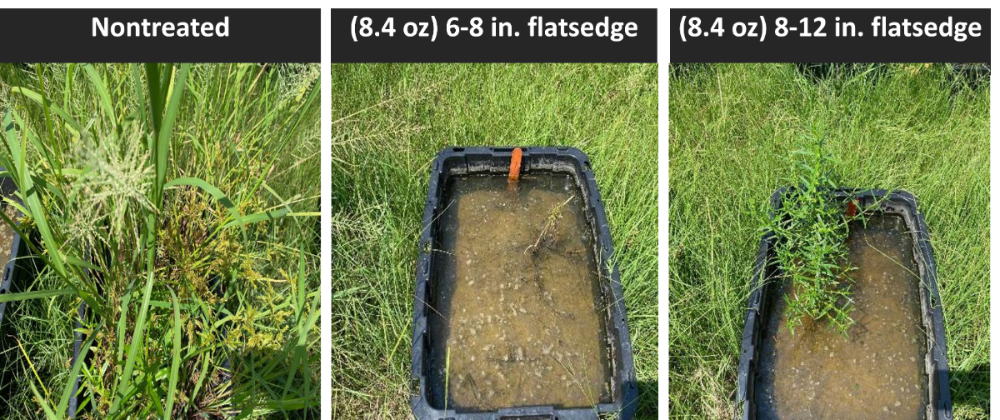Rogue (Benzobicyclon) Herbicide: Recommendations for Arkansas Rice
Rogue (Benzobicyclon) Herbicide: Recommendations for Arkansas Rice
By: Tommy Butts, Jason Norsworthy, and Tom Barber
Rogue (benzobicyclon) received a federal registration for 2022 and provides a new site-of-action (HPPD-inhibitor, bleacher) for use in rice. This herbicide has some great potential benefits, but there are some specific practices we need to follow to truly maximize its effectiveness. Let’s take a more in-depth look at Rogue, what its best used for and where, and other recommendations we have for its use.
What does Rogue control?
Rogue is a post-flood herbicide that has excellent activity on annual flatsedges (especially ALS-inhibitor-resistant populations) (Fig. 1), sprangletop (Fig. 2), and aquatics, among others. It also has the capability to provide some weedy rice suppression. This weedy rice suppression is most effective when Rogue is applied at the max rate (12.6 fl oz/acre) and used in a program approach.

Rogue is a pro-herbicide, meaning it needs to go through a chemical reaction in water before it is herbicidally-active. As a result, it is strictly a post-flood treatment that needs to be sprayed into the flood water (i.e., coverage on rice/weed leaf surfaces does not help the control). Rogue should be used only on zero-grade and straight levee fields where water can be held steady with little to no movement.
What other recommendations do we have?
There are numerous factors to consider when using Rogue on our rice acres. First, the labeled rate range is from 8.4 to 12.6 fl oz/acre. If weeds are small (<8 inches, not tillering), the 8.4 fl oz rate can be used very successfully (Figs. 1 and 2). If weeds are bigger, tillering, or beginning to head (Figs. 1 and 2) or we are looking for weedy rice suppression, the 12.6 fl oz/acre rate is a must. Applications to weeds already heading have not been successful in controlling the weed species (Fig. 2). Blanking of weed seed heads was observed at this rate and timing which is beneficial to reduce additions to the weed seedbank, but this should only be used as a last resort.

Rogue should be applied immediately (within 7 days) following stable flood establishment and prior to 2-tiller rice. Increased control from Rogue has been observed when using a methylated seed oil (MSO) adjuvant mixed at a 1% v/v rate. Additionally, using a bigger droplet size and greater carrier volume than normal will aid in getting the herbicide through rice and weed canopies to the water. Best weed control has been observed with a deep and consistent flood (minimum of 3 inches) and weeds should be at least 70% submerged.
Certification required!
Those planning on using Rogue must first be certified. Users only need to be certified once, although if previously certified under the 2021 Section 18 label, you must re-certify this year. The process includes a short online training video and quiz. In addition, by completing the Rogue certification training, participants can earn 0.5 CEUs in Soil & Water Management. For more details and to become certified, visit the following website: HTTPS://WWW.GOWANCO.COM/ROGUE-SC.
Final thoughts
Rice flatsedge, sprangletop species, and weedy rice are three of our top five most problematic weed species in Arkansas rice. Having a new herbicide, a different tool in the toolbox, to combat these problems is always a welcome addition to our weed management programs. As with other herbicides, applying when weeds are small and using Rogue in a program approach is important for successful weed control and for herbicide resistance management. For more rice weed control information, please make sure to look in our 2022 MP44 Recommended Chemicals for Weed and Brush Control available at your local county Extension office or online here.
We want to wish y’all the best for a successful 2022 growing season, and if there’s ever anything we can help with, please let us know!
